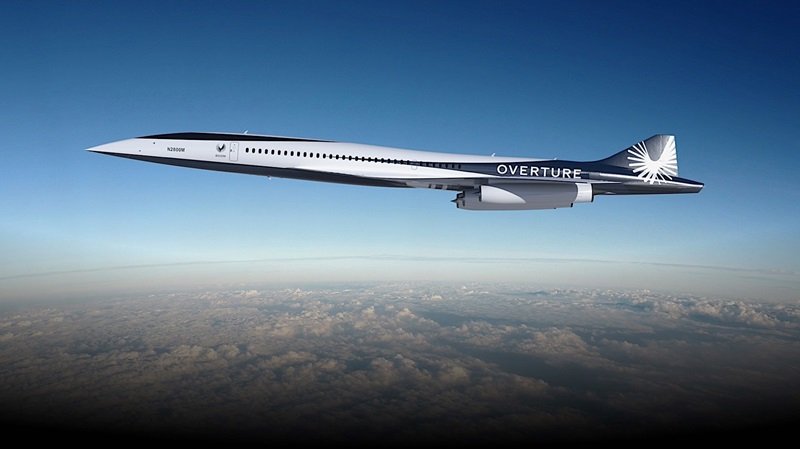Boom Technology: Paving the Way for Supersonic Airliners.
Introduction
In the ever-evolving world of aviation, Boom Technology has emerged as a trailblazer, aiming to revive the era of supersonic commercial flight. Let’s delve into the company’s history, its ambitious projects, and the exciting future it envisions.
The Birth of Boom
Founded in Denver, Colorado in 2014, Boom Technology set out to build what it calls the world’s fastest supersonic airliner. With the grounding of the Concorde nearly two decades ago, the dream of supersonic travel had faded. But Boom reignited that dream, fueled by innovation and a passion for pushing boundaries.
The latest design shows 4 Overture engines mounted beneath the main wings.
The Boom XB-1 Baby Boom
Before unveiling the full-scale Overture, Boom developed the XB-1 Baby Boom, a one-third-scale supersonic demonstrator. Here are the key details:
Design: The XB-1 maintains a cruising speed of Mach 2.2 and boasts over 1,000 nautical miles of range.
Engines: Powered by three General Electric J85-15 engines, each generating 4,300 pounds-force of thrust.
Rollout: The XB-1 was proudly rolled out in October 2020.
While initial flight testing was expected in 2022, delays pushed the first flight to 2024. The XB-1 serves as a crucial stepping stone toward the ultimate goal: the Boom Overture.
A Boom Overture shown in a landing phase. Note the main wheel bogies each with 6 wheels each.
The Boom Overture
The Overture represents Boom’s vision for a commercial supersonic transport. Here are the highlights:
Speed: The Overture aims for a cruising speed of Mach 1.7 (approximately 1,000 knots).
Passenger Capacity: With 65 to 88 seats, it caters to discerning travelers seeking swift, luxurious journeys.
Range: The Overture boasts an impressive 4,250 nautical miles of range, connecting distant cities with ease.
Market Potential: Boom estimates a demand for 1,000 supersonic airliners with business-class fares across 500 viable routes.
Delta Wings and Composite Materials
Taking inspiration from the iconic Concorde, Boom chose the delta wing configuration for the Overture. Additionally, the company leverages composite materials to enhance performance and fuel efficiency. These choices reflect Boom’s commitment to both speed and sustainability.
The Boom Symphony engine, designed for use on the Overture supersonic airliner, is a medium-bypass turbofan under development by Boom Technology.
Engine Configuration
The heart of any supersonic airliner lies in its engines, and the Overture is no exception. Here are the key details:
Four Powerful Engines: The Overture will be equipped with four wing-mounted engines. This configuration not only enhances performance but also contributes to noise reduction and operational efficiency for airlines.
Dual-Speed Capability:
Over Water: The Overture can cruise at Mach 1.7, making it one of the fastest commercial aircraft for transoceanic flights.
Over Land: When flying over land, it operates just below Mach 1, ensuring compliance with sonic boom regulations.
Engine Specifications:
Thrust: Each engine provides 35,000 lbs of thrust during takeoff.
Fuel Efficiency: The Overture’s engines are optimized for 100% Sustainable Aviation Fuel, aligning with the industry’s push toward eco-friendly alternatives.
Quiet Fan Design: The single-stage fan minimizes noise impact.
Advanced Materials: Additive manufacturing techniques reduce weight, part count, and assembly costs.
Certification: The engines meet FAA and EASA Part 33 requirements.
Funding and Milestones
Boom’s journey has been fueled by strategic investments and milestones:
Venture Funding: Boom secured investments from Y Combinator, Sam Altman, Seraph Group, and others.
Japan Airlines: In December 2017, Japan Airlines invested $10 million, enabling the completion of the XB-1 and early design work on the Overture.
NEOM Investment Fund: In November 2023, the NEOM Investment Fund joined the journey, further propelling Boom toward its supersonic goals.
The Road Ahead
As of January 2022, the Overture’s first flight is planned for 2026. Boom envisions a future where supersonic travel is not only faster but also more sustainable. The sleek Overture promises reduced travel times, connecting global cities with unprecedented speed and luxury. Buckle up; the future is about to break the sound barrier!



